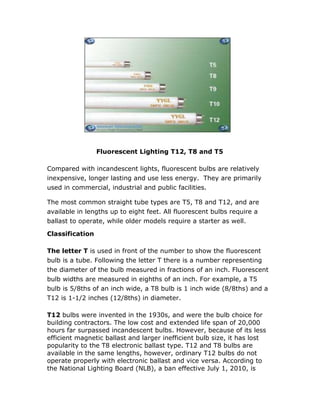
Fluorescent Lighting T12, T8 And T5
- 1. <br /> Fluorescent Lighting T12, T8 and T5<br />Compared with incandescent lights, fluorescent bulbs are relatively inexpensive, longer lasting and use less energy. They are primarily used in commercial, industrial and public facilities.<br />The most common straight tube types are T5, T8 and T12, and are available in lengths up to eight feet. All fluorescent bulbs require a ballast to operate, while older models require a starter as well.<br />Classification<br />The letter T is used in front of the number to show the fluorescent bulb is a tube. Following the letter T there is a number representing the diameter of the bulb measured in fractions of an inch. Fluorescent bulb widths are measured in eighths of an inch. For example, a T5 bulb is 5/8ths of an inch wide, a T8 bulb is 1 inch wide (8/8ths) and a T12 is 1-1/2 inches (12/8ths) in diameter.<br />T12 bulbs were invented in the 1930s, and were the bulb choice for building contractors. The low cost and extended life span of 20,000 hours far surpassed incandescent bulbs. However, because of its less efficient magnetic ballast and larger inefficient bulb size, it has lost popularity to the T8 electronic ballast type. T12 and T8 bulbs are available in the same lengths, however, ordinary T12 bulbs do not operate properly with electronic ballast and vice versa. According to the National Lighting Board (NLB), a ban effective July 1, 2010, is phasing out magnetic ballasts, although excess inventory and T12 bulbs will continue to be sold.<br />T8 bulbs have continued growing in popularity since their introduction to the United States in 1981, and have now become the standard in building construction. The T8 bulb's lifetime meets or exceeds that of the T12, while using less energy. Additionally, the T8 uses electronic ballast, which is more energy efficient than the T12 magnetic type. Since the T8 ballast uses solid-state circuitry to operate, it does not make a loud humming sound nor does it cause light flickering, which is <br />commonly found with the T12 magnetic ballast.<br />T5 fluorescent bulbs, like the T8, use electronic ballast. That is where the similarity ends. The cost of T5 bulbs, especially high output types, is significantly higher than T8 and T12 bulbs. T5 bulbs are also shorter and do not fit standard fixtures. For example, a typical T5 bulb is 46 inches long rather than the 48 inches (4 foot) of T8 and T12 bulbs. However, conversion kits are available with ballast, allowing T5 bulbs to fit T8 and T12 fixtures. T5 bulbs save money over time because of a longer lifespan while producing more light with less wattage. The T5 also maintains maximum light output for almost the entire lifetime of the bulb.<br />Future Technology<br />T5, T8 and T12 LED (light emitting diode) replacement tubes currently on the market fit into existing fluorescent fixtures. The technology of LEDs is different from fluorescent bulbs with advantages and disadvantages. The biggest factor is price, easily costing ten times more. However, they last up to 50,000 hours, use less power to operate without ballast, and do not contain the hazardous mercury that fluorescent bulbs use. Like any new product, cost reduction will depend on improved technology and consumer demand.<br />